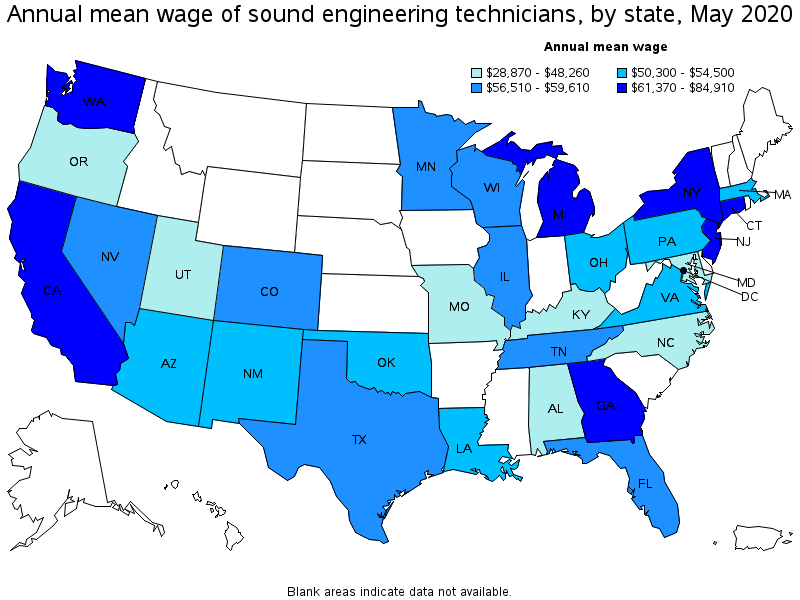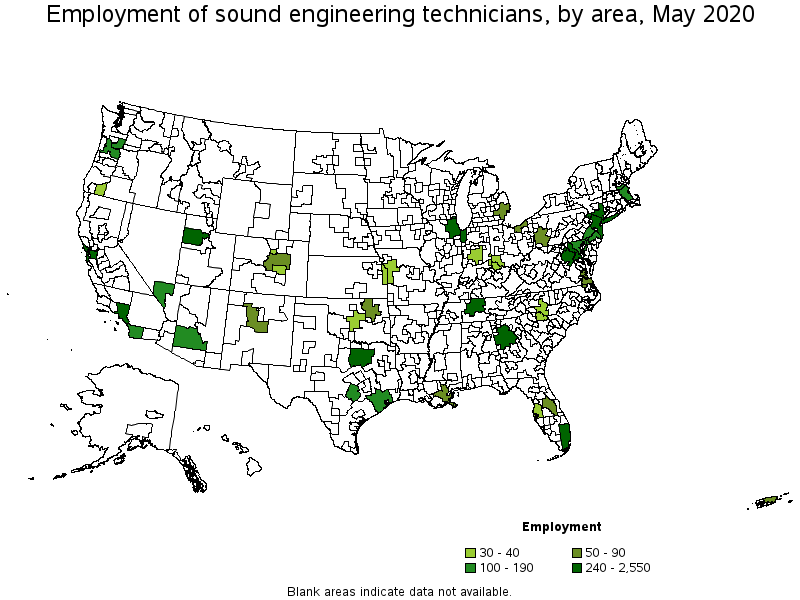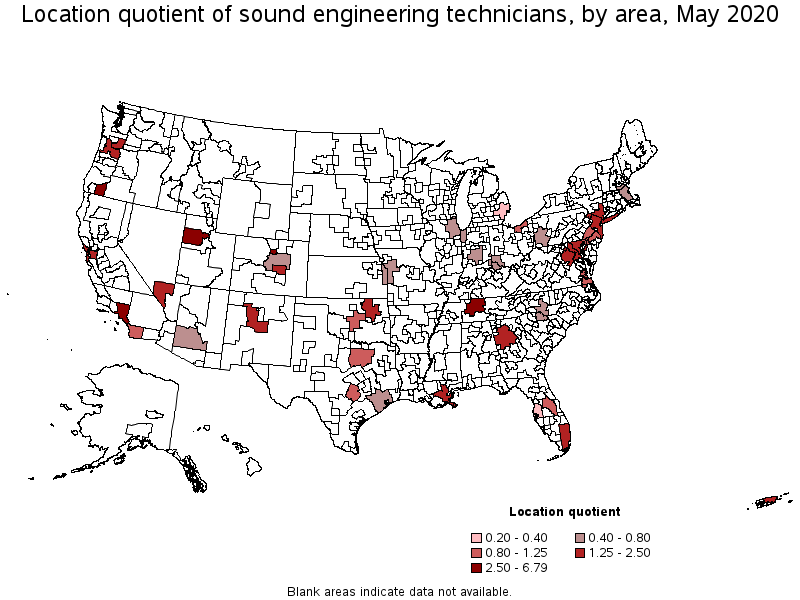An official website of the United States government
 United States Department of Labor
United States Department of Labor
Assemble and operate equipment to record, synchronize, mix, edit, or reproduce sound, including music, voices, or sound effects, for theater, video, film, television, podcasts, sporting events, and other productions. Excludes "Audio and Video Technicians" (27-4011).
Employment estimate and mean wage estimates for Sound Engineering Technicians:
| Employment (1) | Employment RSE (3) |
Mean hourly wage |
Mean annual wage (2) |
Wage RSE (3) |
|---|---|---|---|---|
| 10,870 | 5.2 % | $ 32.31 | $ 67,210 | 4.1 % |
Percentile wage estimates for Sound Engineering Technicians:
| Percentile | 10% | 25% | 50% (Median) |
75% | 90% |
|---|---|---|---|---|---|
| Hourly Wage | $ 13.30 | $ 17.05 | $ 25.73 | $ 37.22 | $ 57.56 |
| Annual Wage (2) | $ 27,650 | $ 35,460 | $ 53,520 | $ 77,410 | $ 119,720 |
Industries with the highest published employment and wages for Sound Engineering Technicians are provided. For a list of all industries with employment in Sound Engineering Technicians, see the Create Customized Tables function.
Industries with the highest levels of employment in Sound Engineering Technicians:
| Industry | Employment (1) | Percent of industry employment | Hourly mean wage | Annual mean wage (2) |
|---|---|---|---|---|
| Sound Recording Industries | 2,900 | 16.11 | $ 32.63 | $ 67,860 |
| Motion Picture and Video Industries | 2,520 | 0.76 | $ 41.98 | $ 87,310 |
| Radio and Television Broadcasting | 700 | 0.34 | $ 27.23 | $ 56,640 |
| Performing Arts Companies | 610 | 0.60 | $ 30.76 | $ 63,980 |
| Colleges, Universities, and Professional Schools | 540 | 0.02 | $ 18.54 | $ 38,570 |
Industries with the highest concentration of employment in Sound Engineering Technicians:
| Industry | Employment (1) | Percent of industry employment | Hourly mean wage | Annual mean wage (2) |
|---|---|---|---|---|
| Sound Recording Industries | 2,900 | 16.11 | $ 32.63 | $ 67,860 |
| Motion Picture and Video Industries | 2,520 | 0.76 | $ 41.98 | $ 87,310 |
| Performing Arts Companies | 610 | 0.60 | $ 30.76 | $ 63,980 |
| Manufacturing and Reproducing Magnetic and Optical Media | 60 | 0.53 | $ 22.34 | $ 46,460 |
| Independent Artists, Writers, and Performers | 250 | 0.53 | $ 33.32 | $ 69,310 |
Top paying industries for Sound Engineering Technicians:
| Industry | Employment (1) | Percent of industry employment | Hourly mean wage | Annual mean wage (2) |
|---|---|---|---|---|
| Advertising, Public Relations, and Related Services | 40 | 0.01 | $ 44.49 | $ 92,550 |
| Motion Picture and Video Industries | 2,520 | 0.76 | $ 41.98 | $ 87,310 |
| Scientific Research and Development Services | 30 | (7) | $ 34.49 | $ 71,740 |
| Employment Services | 160 | (7) | $ 33.55 | $ 69,790 |
| Independent Artists, Writers, and Performers | 250 | 0.53 | $ 33.32 | $ 69,310 |
States and areas with the highest published employment, location quotients, and wages for Sound Engineering Technicians are provided. For a list of all areas with employment in Sound Engineering Technicians, see the Create Customized Tables function.

States with the highest employment level in Sound Engineering Technicians:
| State | Employment (1) | Employment per thousand jobs | Location quotient (9) | Hourly mean wage | Annual mean wage (2) |
|---|---|---|---|---|---|
| California | 3,300 | 0.20 | 2.57 | $ 40.82 | $ 84,910 |
| New York | 1,380 | 0.16 | 2.03 | $ 38.47 | $ 80,030 |
| Florida | 660 | 0.08 | 0.99 | $ 27.17 | $ 56,510 |
| Texas | 580 | 0.05 | 0.61 | $ 27.30 | $ 56,790 |
| Tennessee | 340 | 0.12 | 1.52 | $ 28.10 | $ 58,450 |

States with the highest concentration of jobs and location quotients in Sound Engineering Technicians:
| State | Employment (1) | Employment per thousand jobs | Location quotient (9) | Hourly mean wage | Annual mean wage (2) |
|---|---|---|---|---|---|
| California | 3,300 | 0.20 | 2.57 | $ 40.82 | $ 84,910 |
| Utah | 290 | 0.20 | 2.53 | $ 13.88 | $ 28,870 |
| District of Columbia | 120 | 0.17 | 2.18 | $ 34.58 | $ 71,930 |
| New York | 1,380 | 0.16 | 2.03 | $ 38.47 | $ 80,030 |
| Oregon | 240 | 0.13 | 1.69 | $ 23.20 | $ 48,260 |

Top paying states for Sound Engineering Technicians:
| State | Employment (1) | Employment per thousand jobs | Location quotient (9) | Hourly mean wage | Annual mean wage (2) |
|---|---|---|---|---|---|
| California | 3,300 | 0.20 | 2.57 | $ 40.82 | $ 84,910 |
| New York | 1,380 | 0.16 | 2.03 | $ 38.47 | $ 80,030 |
| Connecticut | 50 | 0.03 | 0.39 | $ 37.83 | $ 78,680 |
| Michigan | 90 | 0.02 | 0.29 | $ 35.19 | $ 73,200 |
| District of Columbia | 120 | 0.17 | 2.18 | $ 34.58 | $ 71,930 |

Metropolitan areas with the highest employment level in Sound Engineering Technicians:
| Metropolitan area | Employment (1) | Employment per thousand jobs | Location quotient (9) | Hourly mean wage | Annual mean wage (2) |
|---|---|---|---|---|---|
| Los Angeles-Long Beach-Anaheim, CA | 2,550 | 0.44 | 5.60 | $ 43.03 | $ 89,500 |
| New York-Newark-Jersey City, NY-NJ-PA | 1,410 | 0.16 | 2.05 | $ 36.92 | $ 76,790 |
| Miami-Fort Lauderdale-West Palm Beach, FL | 370 | 0.15 | 1.90 | $ 26.37 | $ 54,850 |
| Washington-Arlington-Alexandria, DC-VA-MD-WV | 330 | 0.11 | 1.41 | $ 26.57 | $ 55,260 |
| San Francisco-Oakland-Hayward, CA | 300 | 0.13 | 1.67 | $ 32.05 | $ 66,670 |
| Nashville-Davidson--Murfreesboro--Franklin, TN | 290 | 0.30 | 3.89 | $ 29.36 | $ 61,070 |
| Atlanta-Sandy Springs-Roswell, GA | 290 | 0.11 | 1.42 | $ 34.16 | $ 71,060 |
| Salt Lake City, UT | 270 | 0.38 | 4.81 | (8) | (8) |
| Chicago-Naperville-Elgin, IL-IN-WI | 260 | 0.06 | 0.75 | $ 26.90 | $ 55,960 |
| Dallas-Fort Worth-Arlington, TX | 240 | 0.07 | 0.84 | $ 28.83 | $ 59,970 |

Metropolitan areas with the highest concentration of jobs and location quotients in Sound Engineering Technicians:
| Metropolitan area | Employment (1) | Employment per thousand jobs | Location quotient (9) | Hourly mean wage | Annual mean wage (2) |
|---|---|---|---|---|---|
| Medford, OR | 40 | 0.53 | 6.79 | $ 22.55 | $ 46,900 |
| Los Angeles-Long Beach-Anaheim, CA | 2,550 | 0.44 | 5.60 | $ 43.03 | $ 89,500 |
| Salt Lake City, UT | 270 | 0.38 | 4.81 | (8) | (8) |
| Nashville-Davidson--Murfreesboro--Franklin, TN | 290 | 0.30 | 3.89 | $ 29.36 | $ 61,070 |
| Boulder, CO | 40 | 0.24 | 3.06 | $ 31.01 | $ 64,500 |
| New York-Newark-Jersey City, NY-NJ-PA | 1,410 | 0.16 | 2.05 | $ 36.92 | $ 76,790 |
| Miami-Fort Lauderdale-West Palm Beach, FL | 370 | 0.15 | 1.90 | $ 26.37 | $ 54,850 |
| Portland-Vancouver-Hillsboro, OR-WA | 170 | 0.15 | 1.89 | $ 25.38 | $ 52,780 |
| San Francisco-Oakland-Hayward, CA | 300 | 0.13 | 1.67 | $ 32.05 | $ 66,670 |
| Albuquerque, NM | 50 | 0.12 | 1.57 | $ 25.49 | $ 53,030 |

Top paying metropolitan areas for Sound Engineering Technicians:
| Metropolitan area | Employment (1) | Employment per thousand jobs | Location quotient (9) | Hourly mean wage | Annual mean wage (2) |
|---|---|---|---|---|---|
| Los Angeles-Long Beach-Anaheim, CA | 2,550 | 0.44 | 5.60 | $ 43.03 | $ 89,500 |
| New York-Newark-Jersey City, NY-NJ-PA | 1,410 | 0.16 | 2.05 | $ 36.92 | $ 76,790 |
| Tampa-St. Petersburg-Clearwater, FL | 40 | 0.03 | 0.37 | $ 34.49 | $ 71,740 |
| Atlanta-Sandy Springs-Roswell, GA | 290 | 0.11 | 1.42 | $ 34.16 | $ 71,060 |
| San Francisco-Oakland-Hayward, CA | 300 | 0.13 | 1.67 | $ 32.05 | $ 66,670 |
| Orlando-Kissimmee-Sanford, FL | 90 | 0.07 | 0.94 | $ 31.78 | $ 66,090 |
| Boulder, CO | 40 | 0.24 | 3.06 | $ 31.01 | $ 64,500 |
| Denver-Aurora-Lakewood, CO | 70 | 0.05 | 0.64 | $ 29.71 | $ 61,810 |
| Seattle-Tacoma-Bellevue, WA | (8) | (8) | (8) | $ 29.62 | $ 61,610 |
| Nashville-Davidson--Murfreesboro--Franklin, TN | 290 | 0.30 | 3.89 | $ 29.36 | $ 61,070 |
These estimates are calculated with data collected from employers in all industry sectors, all metropolitan and nonmetropolitan areas, and all states and the District of Columbia. The top employment and wage figures are provided above. The complete list is available in the downloadable XLS files.
The percentile wage estimate is the value of a wage below which a certain percent of workers fall. The median wage is the 50th percentile wage estimate—50 percent of workers earn less than the median and 50 percent of workers earn more than the median. More about percentile wages.
(1) Estimates for detailed occupations do not sum to the totals because the totals include occupations not shown separately. Estimates do not include self-employed workers.
(2) Annual wages have been calculated by multiplying the hourly mean wage by a "year-round, full-time" hours figure of 2,080 hours; for those occupations where there is not an hourly wage published, the annual wage has been directly calculated from the reported survey data.
(3) The relative standard error (RSE) is a measure of the reliability of a survey statistic. The smaller the relative standard error, the more precise the estimate.
(7) The value is less than .005 percent of industry employment.
(8) Estimate not released.
(9) The location quotient is the ratio of the area concentration of occupational employment to the national average concentration. A location quotient greater than one indicates the occupation has a higher share of employment than average, and a location quotient less than one indicates the occupation is less prevalent in the area than average.
Other OEWS estimates and related information:
May 2020 National Occupational Employment and Wage Estimates
May 2020 State Occupational Employment and Wage Estimates
May 2020 Metropolitan and Nonmetropolitan Area Occupational Employment and Wage Estimates
May 2020 National Industry-Specific Occupational Employment and Wage Estimates
Last Modified Date: March 31, 2021